
How a Canadian Foundation Exposed the Signs of Sex Trafficking

Did you know that right now, as you are reading this article, someone is being lured into sex trafficking? It’s certainly a grim statistic, and, at the very least, worth a few moments of your time and consideration. But perhaps this will grab your attention just a little longer. Did you know that right now, if you live in Canada, within 1 kilometre, someone is being lured into sex trafficking? The statement speaks for itself, really. Obtained through the Joy Smith Foundation’s research, the value represents how big an issue this is across Canada, and serves as a firm reminder that sex trafficking is something that can happen to anyone, anywhere, and at any time.
It’s frightening, to say the least, and it’s for this reason that creative agency Diamond and the Joy Smith Foundation partnered up to draw attention to this problem. Working with Untitled Films’ directorial team of Taylor Reid, the group created 'See the Trafficking Signs', a powerful national awareness campaign designed to educate viewers on the common signs of someone being at risk of being groomed and lured into sex trafficking.
Featuring a central spot which focuses on the harrowing tales of survivors of sex trafficking, the campaign is also being supported by an extensive paid and organic social using out-of-home and digital banners, all of which lead to the TraffickingSigns.ca website, where additional information can be read and learned.
LBB’s Josh Neufeldt sat down with Diamond SVP and creative director Dave Stevenson, Joy Smith Foundation CEO and president Janet Campbell, and directors Nicholas Taylor and Paul Reid to learn more about how this dark campaign came to life.
LBB> What was the brief for this campaign, and what immediate ideas came to mind?
Janet> Initially, Josh Diamond (SVP, partner at Diamond) approached us about working together. Their team had already developed a passion for the issue, and they had heard about the work of the Joy Smith Foundation, so he reached out to us.
Once we finally connected with Josh, his authenticity and passion for the issue really stood out. It was clear that he genuinely wanted to make an impact, and we could see that same authenticity in David Stevenson when we met him.
During our conversations, we found that the team at Diamond was committed to learning more about the issue. We had the opportunity to experience how they applied their new knowledge and feedback to the creative concepts for the campaign, and it quickly became clear to us that working with Diamond would produce meaningful and impactful outcomes. Overall, they exhibited authenticity, passion, and curiosity. We believed that these qualities, coupled with their expertise and talent, would help us achieve our shared goal of making a meaningful impact.
Dave> The initial brief was simply ‘how do we make a positive impact on the issue of sex trafficking?’. With insight from the Joy Smith Foundation, it became clear that the best way to battle the issue is to keep kids from being lured into it in the first place. We were surprised to learn how sex traffickers can use common techniques to groom and control youth, and that these often appear as common signs that can be recognised if you know what to look for - something that became the core of our approach. We wondered if we could create recognisable ‘trafficking signs’ the way society has already created traffic signs.
LBB> One of the most memorable aspects of the work is the information that less than 1 kilometre from you, someone is being lured into sex trafficking. Where did this insight come from, and what was the research process like?
Dave> This research comes from our partners at the Joy Smith Foundation. As the leading authority on human trafficking in Canada, they are exposed to the realities of the issue - collecting data and research from groups including government, police forces, crisis centres and other sources across the country. The 1 kilometre stat reflects the pervasiveness of the human trafficking crisis. When we heard it, we knew we had to let people know to draw them in to learn more about the signs of trafficking.
Janet> This statement is not just a hook, but a harsh reality. It is widely accepted that human trafficking statistics in Canada are vastly underreported, and as an organisation, we witness this reality daily through our work. Our team has helped over 7,000 victims of human trafficking. When we provide educational presentations, we often cite the number of cases we've assisted in the immediate area of the presentation. After most presentations, we are approached by a victim or survivor, demonstrating that the problem is genuine and closer to home than many people may believe. Moreover, social media has become a popular tool for traffickers to recruit individuals, removing geography as a barrier for potential victims. Therefore, this understanding was critical to our creative process, as it allowed us to convey the urgency and proximity of the problem powerfully and memorably to all Canadians.
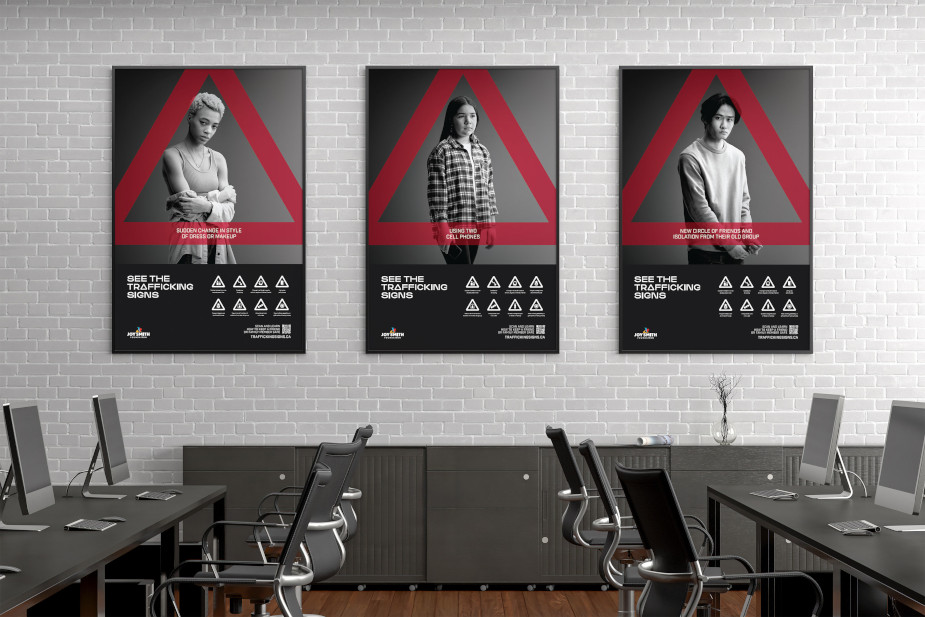
LBB> Sex trafficking is a sensitive but critical topic to discuss. As such, how did you approach the creative in a thoughtful yet meaningful way?
Dave> There were a number of considerations in approaching this topic. The first and most important was to be authentic in the representation of the issue. The stories surrounding the signs had to be based on reality. And when choosing the ages and diversity of the young cast, we wanted to avoid glamorising the issue, or sexualising any part of it. In movies and television, sex trafficking is often shown as something experienced by ‘others’ - people from other places or backgrounds. We needed to show that this is an issue happening everywhere, with youth impacted from all backgrounds, incomes, and ethnicities.
The other major consideration was to protect the victims we were working with. Protecting their identities and respecting their personal situations was critical. Many had only recently escaped from abuse and could easily be retraumatised. And for most, revealing their identities or recounting detailed stories would put them in danger from those who once trafficked them - we’re talking organised crime and gangs working across the country and internationally.
LBB> Speaking of common signs of sex trafficking, what should Canadians look for, and how can they help join the fight?
Janet> It's important to know the signs of trafficking so that we can help prevent it from happening. Here are some common signs that Canadians should look for:
- Sudden interest in a man several years older.
- New clothing, jewellery, or gifts without having money.
- Frequent sleepovers.
- Sudden change in style of dress or makeup.
- New circle of friends and isolation from their old group.
- Change in attitude towards school, regular activities, friends.
- Grades are dropping.
- Unexplained cuts or bruises.
- Using two cell phones.
It's important to note that these signs don't necessarily mean that someone is being trafficked, but they could indicate that something is amiss, and it's important to investigate further. Additionally, education is our greatest weapon against sex trafficking. By learning about the issue and the signs of trafficking, we can help protect our families and our communities. That's why we encourage everyone to visit traffickingsigns.ca to learn more and use our free resources.
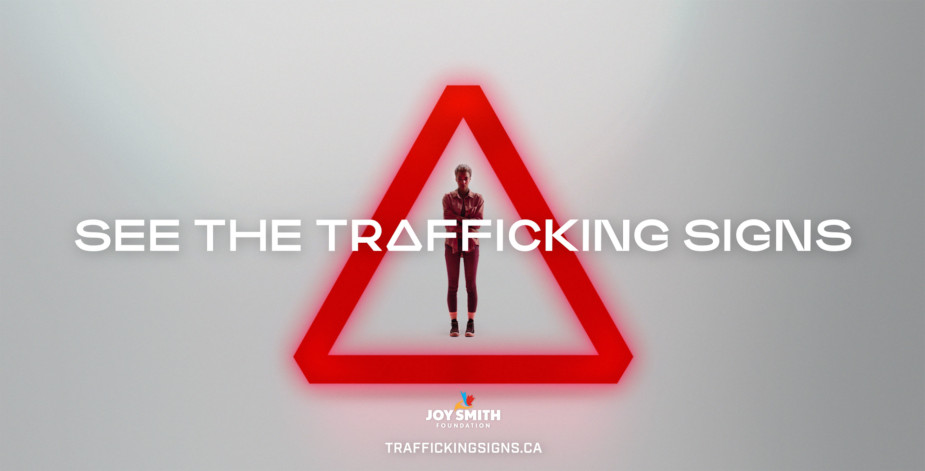
LBB> A key part of the campaign is the triangle sign visual motif. How did this come to pass, and what does it represent?
Dave> It’s pretty simple. We wanted to create warning signs represented by the familiar red triangle you might see on a road sign. Originally, we had all the signs look like road signs with icons, rather than photography in the middle of the triangle. But as we started to develop the campaign, we realised that the red warning triangle paired with the visuals of youth felt much more impactful and emotional. We’ve kept those icon-based signs for the educational portion of the campaign - on the website and in training material - but the awareness-driving work now includes powerful black and white photography.

LBB> Let’s talk about the spot itself. What went into the creation of the script, and what was the writing process like?
Dave> The script is based on true stories. In fact, many of the experiences we describe are all too common among survivors. We drew on many shocking accounts from women and men, girls and boys, all from across Canada. The ultimate challenge was narrowing and selecting from the stories, as we had to create a singular narrative that reflected the emotional journey of someone being lured into trafficking: from joy and excitement to fear and, in many cases, horror.
LBB> Nicholas and Paul, what was the script for this campaign like? What immediate ideas came to mind when you first saw it, and why was it something that you were keen to get involved in?
Nicholas & Paul> David Stevenson and the team at Diamond had a powerful concept around the idea of warning signs in their original brief. This was accompanied by imagery of black and white silhouettes set starkly against a white backdrop - a concept which really felt unique in that it focused on the victims of human trafficking.
Having worked with the Joy Smith Foundation for years (and having done very lengthy interviews with actual victims), we felt it was important to create a strong piece that humanised victims of trafficking. Many of the projects that have been produced around human trafficking focused more on the traffickers and presented the subject matter in a way that was dark and, we feel, easy to ignore. While we wanted people to feel the emotion and trauma, we didn’t want this to feel like ‘flies in the eyes’ marketing. We wanted to create a visual style that showed the fear, trauma, abuse, and hardship that victims of human trafficking are subjected to. The goal of this was to do it through the lens of empathy, connecting with each character on screen in an intimate and personal way.
LBB> What was the initial concepting process like? How did the idea for the spot evolve, and how did you approach building the spot?
Paul> The concept began with an amazing idea brought to the table by David and Andrew Mowbray (creative director and art director at Diamond), and we thought it worked very well. Something that we liked about the concept was that the spot starts as a very positive piece - almost like a Valentine's Day commercial - then quickly gets dark.
Nicholas> We worked with the Diamond team to build a script that felt representative of how a woman is lured into sex trafficking. It’s a process that starts with what feels like love - the trafficker will shower girls with praise, with gifts, and make them feel special - but then, subtly, things will change. Threats are made, the girls are made to feel like they have to pay back the gifts, and next thing they know they are trapped in a living hell.
We wanted to capture that full emotional journey with this spot, so we worked on structuring it in that way. The thought was, on your first watch, the start of the spot should feel bright and hopeful, then it progressively gets darker and darker. We thought the sign could work as a motif that shows the emotional journey of a victim. There are warning signs, but things feel good, but also, progressively, the signs get more and more alarming and by the time they're apparent, it’s often too late to get out. As such, we wanted to slowly introduce this red light into the spot, creating the question of what it was and creating a visual representation of these warning signs.

LBB> Tell us about the casting. Who did you work with for the shoot, and how did you help to bring out their best performances?
Nicholas> We worked with Andrew Hayes at Powerhouse for casting. He and his team put a lot of work in to find the right talent for this project. It’s a difficult subject, and Andrew was amazing at explaining to agents, actors, and parents why we were doing this, and why it was important.
We knew it was very important to get emotional buy-in from the actors, since the subject matter is so heavy. Before we started shooting, we took each actor aside separately to walk them through what we were looking for. We explained the work that the Joy Smith Foundation does, talked about how many women the organisation has saved from human trafficking, and discussed why we thought this piece was so important. I think that helped to get them in the right headspace. It was important to us that everyone on screen understood what we were doing and why we were doing it. This whole campaign was about pushing for compassion and empathy - to humanise the victims of trafficking. By explaining this to the actors I think it gave them the licence to push their performances.
It was also important to create a relaxing environment where the actors felt safe and comfortable. To achieve this, we kept the crew on set to a minimum, in order to have a smaller footprint and to help put the actors at ease. We kept the communication very clear, explaining what performances we were looking for, and why. Our AD, Bailey Abercrombie, is a very kind and positive force on set, so she was a huge asset in making sure that the actors felt safe being vulnerable on screen.
Paul> With our background in the action-sport and documentary world, we are used to working with regular people that aren’t necessarily used to big crews or lighting setups. We find this can sometimes affect how people are on camera when it's not as intimate as possible.
With the lighting setups done already, we tried to limit the amount of crew on set, especially in the line of sight of talent during their performances. We wanted it to be as intimate as possible for them to feel the emotion in the script, and this was achieved successfully.
LBB> Building on this, how was the shoot? Do you have any memorable stories from production?
Dave> The shoot was much more emotional than any of us expected. We anticipated it might be challenging working with young actors on such a heavy topic, especially since some of the actors had little on-camera experience, but they were amazing! There were times when those from the agency and the clients were losing it; the performances projected on screen really triggered strong emotions. I remember having to pause after certain takes to make sure my voice wouldn’t break when I spoke. There were tears for sure, and plenty of moments of ‘WOW! that captures the essence of what these young survivors feel’. It was impressive.
The cast, directors, first AD and entire crew were all fantastic and sensitive at allowing the heavy moments to happen, before lightening the mood so we could move on.
Paul> We shot in Toronto, at Pie in the Sky studios. It was a one-day shoot, with a prep day for camera and a lighting test day to ensure the VFX team at Darling had everything they needed to make the warning sign come to life. We work with our gaffer, Rorry Somerville, very often so he knew exactly what we were looking for from the beginning. He essentially had all the different lighting setups built out and pre-set on his iPad so he could change the lighting on demand, and we could run through all the lighting setups for each talent effectively.
Nicholas> The experience was great! Toronto has been home base for Paul and I since we started, and Tom Evelyn and Lexy Kavluk are world-class EPs. We've been very lucky to have an amazing group of collaborators that we work with on almost every project. The team we have around us is incredible and they all bring great joy to production. So, although the subject matter was heavy, we had a wonderful time on set.
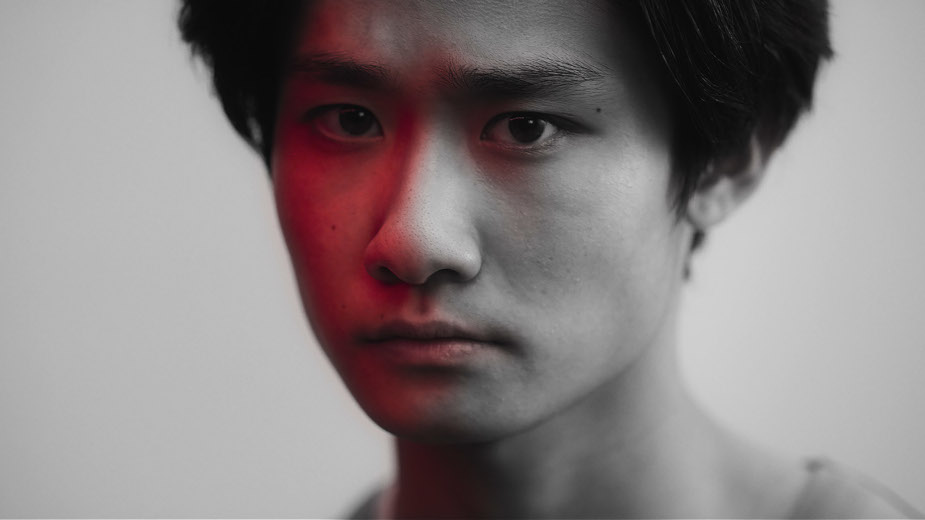
LBB> Visually, the spot is fairly simple, focusing on the speakers themselves. Did this pose any challenges, compared to a spot with lots of action and different locations?
Paul> It was quite simple, production-wise. We are used to more action-based, high-energy work, so to be contained in a studio with the camera and lighting all controlled and mapped out ahead of time - this made the production day quite smooth and allowed us to focus on the performances.
Nicholas> It was an interesting approach to us because, as you point out, a lot of our past work has been high-action, with a lot of scenes and locations. For this project we wanted to keep the focus on humanising the victims of trafficking - making something that felt unique in the space. We felt keeping it very simple by focusing on the talent and their performances was a powerful way to put the viewer inside the head of these victims.
We’re also really glad to have had the incredibly talented Steve Puhach from Nimiopere as the editor. I think the fear with something like this is that it feels too simple in the edit, but Steve went through every shot in detail to find the strongest performances and built a nice structure around what we shot. The little moments and subtle effects that he worked in helped to elevate the storytelling. He also found some amazing reference tracks that made the beginning feel fluffy and joyful, which supported the misdirect.
LBB> The use of colour to match the shift in tone is very poignant. How did you work to achieve this end result?
Paul> The lighting setup was very efficient and we were able to go from full brightness to full darkness with red highlights, and everything in between. In the script, the red highlights were slowly introduced as the script got dark, as if the warning signs were slowly starting to become apparent. On set, we found the black background with the red highlight looked very emotional and moody.
Nicholas> Thank you! It was a tricky one to achieve, but we thought it was a unique way to approach this visually. We did a few tests and talked beforehand with our colourist Patrick Samaniego, and he felt confident he could achieve the effect. So, we shot in colour with the red light accents. From there, he basically went in and isolated that colour and graded the rest of the subjects’ faces to black and white. 500 masks later and we were done, haha.
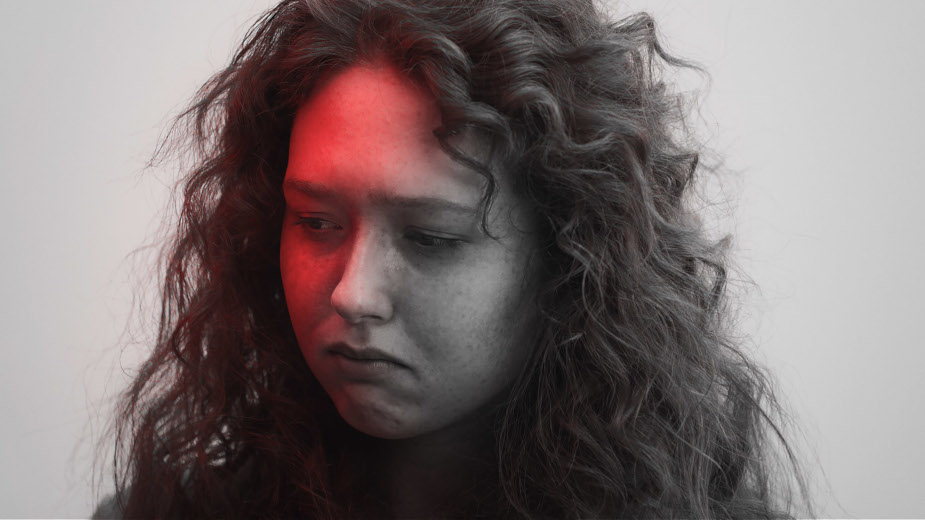
LBB> The sound is excellent, from the transition of happy music to ominous whispering in the background. How did these aspects come to life?
Dave> That was the inspiration of our audio lead, Jared Kuemper at Berkeley Music. The entire concept was to compress the emotional journey of a young person being drawn into sex trafficking. Those sounds are reflective of the swirling fearful thoughts and judgmental voices that haunt survivors, even after they escape.
The initial music approach came in the first round of edits. We knew we wanted a transition from a happy ‘Gap ad’ or ‘dating app’ feel into a more horror movie vibe. The edit team and directors looked for the most innocent, stereotypical romantic track possible, then degraded the tune into something nightmarish. We’re really happy with that and the sound design.
LBB> What challenges have you faced during this project? How did you overcome them?
Dave> The biggest challenge was staying true to the experience of actual survivors. Originally, we wanted to cast real survivors, but moved away from that because of the emotional strain and safety issues it would burden them with. So the challenge was in writing the scripts, casting the characters and editing the story, as we wanted everything to feel authentic and truthful. But honestly, everything went smoothly because the people at the Joy Smith Foundation and our production partners were all focused on making this happen - and happen in line with a shared vision.
Paul> The biggest challenge we faced was the logistics around the end shot revealing the warning sign. We wondered if it was ideal to have VFX put in, or if it was best to build the triangle in real life. We landed on the idea of using VFX in combination with a triangle of red tubes, so the light is accurately casted onto the talent. We felt it worked out and we were really happy with the result.
Janet> As a non-profit organisation, we face many challenges when it comes to our resources and expenses, and this project was no exception. Despite the generosity of the team at Diamond, one of the main obstacles we encountered was the need to raise funds to cover the campaign costs. However, thanks to the great material provided by Diamond, we were able to effectively share our concept and creative with targeted donors, which helped us secure the funding we needed to move forward with the campaign.
Despite this success, we still faced the ongoing challenge of balancing our resources and expenses throughout the project. This required careful planning, budgeting, and prioritisation to ensure that we could achieve our goals without exceeding our means. Through strategic decision-making and effective communication with our team and partners, we were able to overcome these challenges and move forward with confidence.
LBB> Since release, what has the initial response been like?
Dave> The response has been everything we hoped for and more. The media has picked up on it. Other agencies and media providers have donated airtime, online, and physical media right across Canada. Governments and government organisations, major corporations, community groups and individuals of all kinds have been amplifying the campaign through their own networks. The donations of time, media and support are overwhelming.
The traffic to the website and the Joy Smith Foundation site is also impressive. Requests for information, counselling, seminars, and resources are coming in from across the country. And best of all, young people are coming forward to seek the help they need.
Janet> The overwhelming response we received from outdoor advertising, media companies and volunteers has left us eternally grateful. We have had thousands of people come to the traffickingsigns.ca and the joysmithfoundation.com websites, showing a true interest and engagement with our message. Additionally, we have received intervention phone calls as a result of the campaign, which demonstrates the power and impact of our message. In fact, right after the launch press conference, calls came into police organisations that were the direct result of the coverage of the campaign.
I was in Toronto for a few days after the launch, and had more than one conversation with people who knew who I was and referenced the billboards and media interviews, showing that our campaign has truly made an impact and raised awareness of our cause. And, in addition to that, the campaign has received over 125 million media impressions.
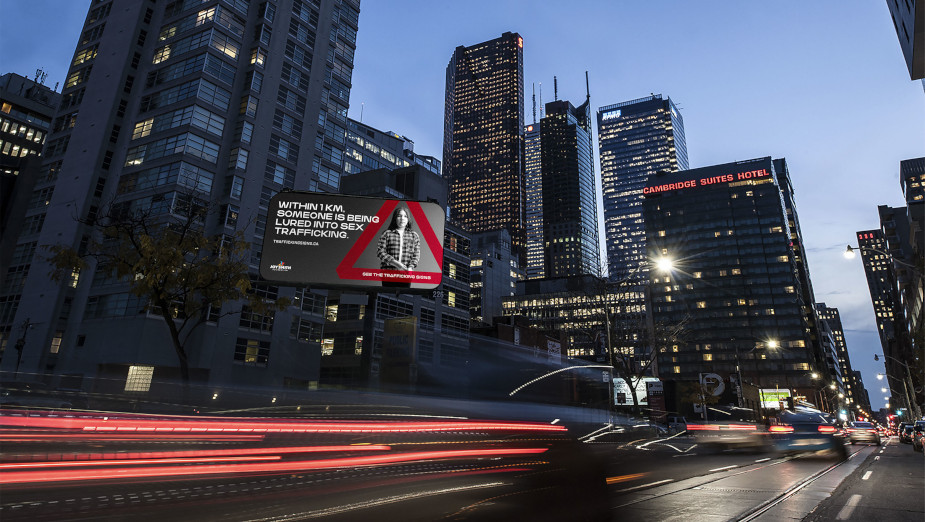
LBB> Is there anything you’d like to tell readers about the Joy Smith Foundation, and how they can support the work you’re doing?
Janet> At the Joy Smith Foundation, we are a family-based organisation with three generations involved, and we have been working tirelessly to combat human trafficking for over 25 years. In fact, my mother made Canadian history when she passed two private members bills that are now embedded in the Criminal Code of Canada to combat human trafficking. As a result, when Canadians see a headline about human trafficking charges laid, that is a direct result of those bills. This deep connection to the issue in Canada drives our passion and commitment to end human trafficking and protect vulnerable individuals.
We believe that raising awareness is key to our success, and we encourage readers to review our educational materials and take a course at NHTEC to learn more about human trafficking and how they can help.
In addition, supporting the Joy Smith Foundation through a donation can help us continue to provide free education materials and support to victims of human trafficking, so that they can heal and restore their lives. Your support can make a real difference in the lives of those affected by this heinous crime.













